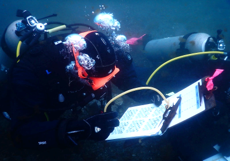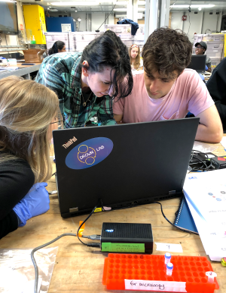BLaST Scientist of the Month: Michael Martins

BLaST Scholar Michael Martins at the Permafrost Tunnels in Fairbanks, Alaska, May 2023.
Since 2016, the Biomedical Learning and Student Training program at UAF has highlighted scientists from all biomedical fields through its Scientist of the Month articles. Michael Martins, a fourth-year BLaST Scholar, was selected Scientist of the month for February 2024. Read more about BLaST's Scientist of the Month series on their website.
Michael Martins, a Brazilian and American citizen, is a fourth-year BLaST Scholar and a senior at UAF. Martins will graduate in May 2024 with a B.S. in mathematics and a minor in Arctic skills and will join the Research Vessel (R/V) Thomas G. Thompson as part of the Arabian Sea Transition Layer (ASTRaL) Departmental Research Initiative in Goa, India. He plans to pursue an Alaska-based fellowship and serve in the NOAA Corps, one of the nation’s eight uniformed services. Martins enjoys ski-mountaineering and playing chess in his free time.
Martins’ current research investigates a new method to derive wind and temperature readings within the ionosphere using artificial airglow, which can be created by ionospheric heaters at UAF’s High Frequency Active Auroral Research Program.

Classmates play chess in cold water in the AAUS dive program at the NOAA Kasitsna Bay Laboratory, March 2023.
“This place is the heart of my research, and they have the biggest ionosphere heater in the world” he shared.
Martins plans to present his findings at the 2024 Coupling, Energetics and Dynamics of Atmospheric Regions Workshop to be held in June at San Diego, California. Martins’ previous research started in the Nearshore Ecology Field Course (MSLF 421) where he proposed and developed a research question investigating the effect of cold water in scuba diving on cognitive performance, with a particular focus on chess puzzle-solving ability. He tested his hypothesis during spring break with the UAF (AAUS) dive program at the Kasitsna Bay Laboratory, a NOAA field station located near Seldovia, Alaska.

Martins, right, with former BLaST postdoc Dr. Anne-Lise Ducluzeau, middle, and a classmate aboard the R/V Sikuliaq, May 2019.
His findings were published in May 2023 by the Chessable Science team through a Chessable Research Award, a competitively selected chess research project from university-based researchers. Martins also participated in May 2019 in the STEMSEAS program for undergraduates aboard UAF’s R/V Sikuliaq on a nine-day transit from San Diego, California to Seward, Alaska, where he helped conduct research ranging from Next-Generation Sequencing using the Oxford Nanopore MinION, examinations of lead contamination using an XRF for elemental analysis and collecting and analyzing data from CTD casts. With help from an American Geophysical Union travel grant, Martins presented on his experience at the 2019 AGU Annual Conference held in San Francisco, California.
Martins credits his success to his mentors who invest in him tirelessly. He feels fortunate to work on his dream research project under the mentorship of Dr. Mark Conde who previously worked with Martins through the Undergraduate Research and Scholarly Activity program. Martins appreciates the advocacy of his Research, Advising, and Mentoring Professionals, Nikola Nikolic, Emily Sousa, and especially Dr. Andrew Cyr. Martins also appreciates the mentorship of JR Ancheta, Heidi Shepard, and Evita Maniatopoulou in earning the 2023 Gold Congressional Award, a national award by the United States Congress’ only non-profit and highest honor for youth civilians. Martins considers himself extremely privileged to be also mentored by Eduardo Jany, Dr. Benjamin Keisling, Dr. Brenda Konar, and peer-mentor, Torin Hooge.


